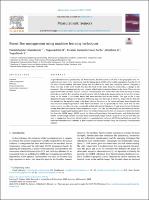| dc.contributor.author | Harishchander, Anandaram | |
| dc.contributor.author | Nagalakshmi, M | |
| dc.contributor.author | Cosio Borda, Ricardo Fernando | |
| dc.contributor.author | Kiruthika, K | |
| dc.contributor.author | Yogadinesh, S | |
| dc.date.accessioned | 2023-11-30T21:11:01Z | |
| dc.date.available | 2023-11-30T21:11:01Z | |
| dc.date.issued | 2023 | |
| dc.identifier.uri | https://hdl.handle.net/20.500.13067/2832 | |
| dc.description.abstract | As per the latest survey produced by the Forest Survey, the forest cover is 19.27% of the geographic area. According to this report every country can meet the human needs of 16% of the world’s population from the 1% of the world’s forest resource. The Forest Survey said that 90% of the forest fires created by humans. They pose a threat not only to the forest wealth but also this leads to the main threat to biodiversity, a change in the ecosystem. The environment gets dry and twinges, which leads to produce flames in the forest. There are two types of forest fire i) Surface Fire and ii) Crown Fire iii) Ground Fire. Surface Fire: The forest fire starts its flame primarily as a surface fire, spreading along the ground with the help of dry grasses and so on. Crown Fire: It starts flame on the crown of the shrubs, bushes and trees and sustained on the surface. This type of fire is very dangerous because resinous material given off burning logs burn furiously. If there is a slope with fire then the fire spread from the top of the slope to the down. Ground fire occurs in the humus and peaty layers beneath the litter of under composed portion of forest floor with intense heat but practically no flame. Such fires are relatively rare and have been recorded occasionally at high altitudes in Himalayan fir and spruce forests. In Remote sensing field, the knowledge of surface temperature plays a vital role. By using brightness and emissivity feature, temperature mapping and analysis can be done. The surface temperature values are measured to detect the forest fire from the ASTER image. ASTER stands for Advanced Space borne Thermal Emission and Reflection Radiometer. ASTER image contains 5 thermal bands (wave length ranges from 8.125 μm to 11.65 μm) and these are used in comparison. To convert digital numbers to exoatmospheric radiance, ASTER thermal bands are used. The converted exoatmospheric radiance is then mapped into surface radiance using the Emissivity Normalization method. | es_PE |
| dc.format | application/pdf | es_PE |
| dc.language.iso | eng | es_PE |
| dc.publisher | Elsevier | es_PE |
| dc.rights | info:eu-repo/semantics/openAccess | es_PE |
| dc.rights.uri | https://creativecommons.org/licenses/by-nc-nd/4.0/ | es_PE |
| dc.subject | Safety management | es_PE |
| dc.subject | Efficiency | es_PE |
| dc.subject | Ground temperature | es_PE |
| dc.subject | Land surface temperature | es_PE |
| dc.subject | Radiance | es_PE |
| dc.title | Forest fire management using machine learning techniques | es_PE |
| dc.type | info:eu-repo/semantics/article | es_PE |
| dc.identifier.journal | Measurement: Sensors | es_PE |
| dc.identifier.doi | https://doi.org/10.1016/j.measen.2022.100659 | |
| dc.subject.ocde | https://purl.org/pe-repo/ocde/ford#2.02.04 | es_PE |
| dc.source.volume | 25 | es_PE |
| dc.source.issue | 2023 | es_PE |
| dc.source.beginpage | 1 | es_PE |
| dc.source.endpage | 6 | es_PE |


